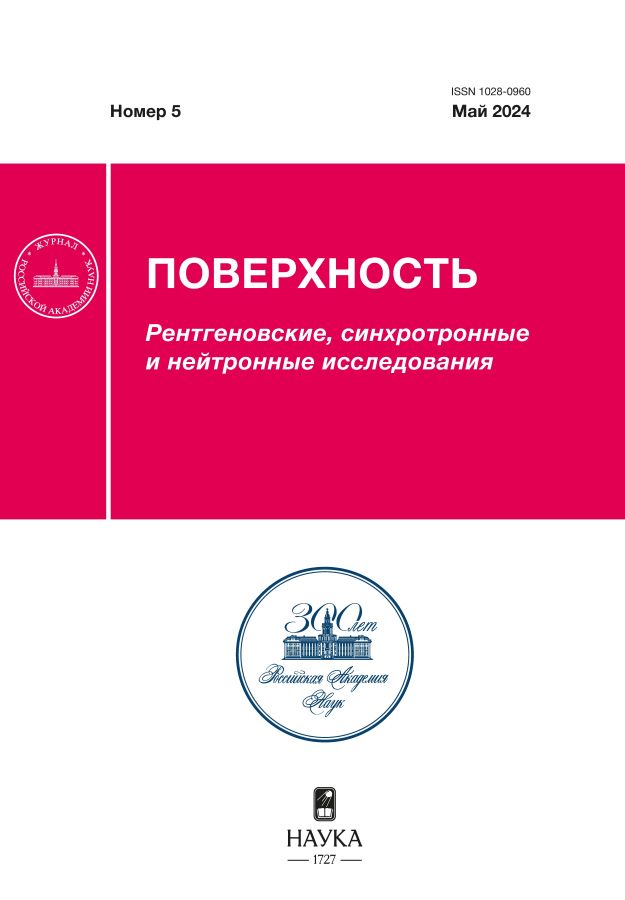Deposition of Wear-Resistant Nanocomposite Coatings from Accelerated С60 Ions
- Authors: Pukha V.E.1,2, Drozdova E.I.3, Chernogorova O.P.3, Lukina I.N.3, Petrzhik M.I.4, Belmesov A.A.1
-
Affiliations:
- Federal Research Center of Problems of Chemical Physics and Medicinal Chemistry, RAS
- Hydrogen Energy Center, Ltd. (Sistema JFC PJSC)
- Baikov Institute of Metallurgy and Material Science
- MISIS National University of Science and Technology
- Issue: No 5 (2024)
- Pages: 45-52
- Section: Articles
- URL: https://archivog.com/1028-0960/article/view/664641
- DOI: https://doi.org/10.31857/S1028096024050079
- EDN: https://elibrary.ru/FTZDXR
- ID: 664641
Cite item
Abstract
Hard wear-resistant carbon coatings were deposited from accelerated C60 ions at temperatures of 200 and 300°C. It has been established that the mechanical properties of the coatings are determined by the substrate temperature (Ts) and the energy composition of the beam. The hardness of coatings deposited from C+60 ions with an energy of 7 keV exceeds 50 GPa and is virtually independent of Ts. The presence of C602+ and C603+ with an energy of ~14 and 21 keV, respectively, in the beam leads to a result that is not typical for carbon coatings – the hardness increases by more than 1.3 times with an increase in Ts from 200 to 300°C (from 31.6 GPa to 41.6 GPa). In this case, according to Raman spectroscopy data, the size of graphite nanocrystals in the coating increases with temperature up to almost 2 nm. Coatings obtained under conditions of irradiation with C602+ and C603+ ions are characterized by minimal wear (1.5×10–8 mm3/N∙m, Ts = 200°C) and minimal friction coefficient (µ = 0.05 for Ts = 300°C). We attribute the unusual dependence of hardness on Ts and the improvement in the tribological properties of coatings to the formation of a composite structure based on a diamond-like matrix and graphite nanocrystals in this range of Ts.
Full Text
About the authors
V. E. Pukha
Federal Research Center of Problems of Chemical Physics and Medicinal Chemistry, RAS; Hydrogen Energy Center, Ltd. (Sistema JFC PJSC)
Author for correspondence.
Email: pve@icp.ac.ru
Russian Federation, Chernogolovka; Chernogolovka
E. I. Drozdova
Baikov Institute of Metallurgy and Material Science
Email: pve@icp.ac.ru
Russian Federation, Moscow
O. P. Chernogorova
Baikov Institute of Metallurgy and Material Science
Email: pve@icp.ac.ru
Russian Federation, Moscow
I. N. Lukina
Baikov Institute of Metallurgy and Material Science
Email: pve@icp.ac.ru
Russian Federation, Moscow
M. I. Petrzhik
MISIS National University of Science and Technology
Email: pve@icp.ac.ru
Russian Federation, Moscow
A. A. Belmesov
Federal Research Center of Problems of Chemical Physics and Medicinal Chemistry, RAS
Email: pve@icp.ac.ru
Russian Federation, Chernogolovka
References
- Singh H., Ramirez G., Eryilmaz O., Greco A., Doll G., Erdemir A. // Tribology International. 2016. V. 98. P. 172. https://doi.org/10.1016/j.triboint.2016.02.008
- Su Y., Cai L., Huang W., Zhang T., Yu W., Zhang P., Hu R. Gong X. // Vacuum. 2022. V. 198. P. 110920. https://doi.org/10.1016/j.vacuum.2022.110920
- Mutyala K.C., Singh H., Evans R.D., Doll G.L. // Surf. Coat. Technol. 2015. V. 284. P. 302. https://doi.org/10.1016/j.surfcoat.2015.06.075
- Bhat A., Budholiya S., Aravind Raj S., Sultan M.T.H., Hui D., Md Shah A.U., Safri S.N.A. // Nanotechnol. Rev. 2021. V. 10. № 1. P. 237. https://doi.org/10.1515/ntrev-2021-0018
- Sánchez-López J.C., Martínez-Martínez D., López-Cartes C., Fernández A. // Surf. Coat. Technol. 2008. V. 202. № 16. P. 4011. https://doi.org/10.1016/j.surfcoat.2008.02.012
- Schultrich B. Tetrahedrally Bonded Amorphous Carbon Films I: Basics, Structure and Preparation. Springer, 2018. V. 263.
- Shi B., Wu Y., Liu Y., Wang L., Gao J., Hei H., Zheng K.Yu.S. // Mater. Sci. Technol. 2022. V. 38. № 15. P. 1151. https://doi.org/10.1080/02670836.2022.2074124
- Charitidis C.A. // Int. J. Refractory Metals Hard Mater. 2010. V. 28. № 1. P. 51. https://doi.org/10.1016/j.ijrmhm.2009.08.003
- Zhang L., Wang F., Qiang L., Gao K., Zhang B., Zhang J. // RSC Adv. 2015. V. 5. № 13. P. 9635. https://doi.org/10.1039/C4RA14078H
- Liu L., Tang W., Ruan Q., Wu Z., Yang C., Cui S., Ma Z., Fu R.K.Y., Tian X., Wang R., Wu Z., Chu P.K. // Surf. Coat. Technol. 2020. V. 404. P. 126468. https://doi.org/10.1016/j.surfcoat.2020.126468
- He D., Shang L., Li W., Cheng B., Zhai H., Zhang X., Lu Z., Zhang, G. // Mater. Design. 2023. V. 226 P. 111640. https://doi.org/10.1016/j.matdes.2023.111640
- Santiago J.A., Fernández-Martínez I., Sánchez-López J.C., Rojas T.C., Wennberg A., Bellido-González V., Molina-Aldareguia J.M., Monclús M.A., González-Arrabal R. // Surf. Coat. Technol. 2020. V. 382. P. 124899. https://doi.org/10.1016/j.surfcoat.2019.124899
- Murugan V.S., Madhu S. // Silicon. 2022. V. 14. № 11. P. 6053. https://doi.org/10.1007/s12633-021-01375-y
- Tyagi A., Walia R.S., Murtaza Q., Pandey S.M., Tyagi P.K., Bajaj B. // Int. J. Refractory Metals Hard Mater. 2019. V. 78. P. 107. https://doi.org/10.1016/j.ijrmhm.2018.09.006
- Zhai W., Srikanth N., Kong L.B., Zhou K. // Carbon. 2017. V. 119. P. 150. https://doi.org/10.1016/j.carbon.2017.04.027
- Penkov O.V., Pukha V.E., Zubarev E.N., Yoo S.S., Kim D.E. // Tribol. Int. 2013. V. 60. P. 127. https://doi.org/10.1016/j.triboint.2012.11.011
- Бельмесов А.А., Нечаев Г.В., Пуха В.Е. Кабачков Е.Н., Ходос И.И., Карасев П.А. // Поверхность. Рентген., синхротр.и нейтрон. исслед. 2022. № 4. C. 3. https://doi.org/10.31857/S1028096022040021
- Малеев М.В., Зубарев Е.Н., Пуха В.Е., Дроздов А.Н., Вус А.С. // Металлофизика и новейшие технологии. 2015. Т. 37. № 6. С. 777. http://dspace.nbuv.gov.ua/handle/123456789/112255
- Петржик М.И., Левашов Е.А. // Кристаллография. 2007. Т. 52. № 6. С. 1002.
- Johnson K.L. Contact Mechanics. Cambridge University Press: Cambridge, 1985.
- Хрущов М.М., Бабичев М.А. Исследования изнашивания металлов. М.: Изд-во Акад. наук СССР, 1960. 351 с.
- Ferrari A.C., Robertson J. // Phys. Rev. B. 2000. V. 61. № 20. P. 14095. https://doi.org/10.1103/PhysRevB.61.14095
- Ferrari A.C. // Surf. Coat. Technol. 2004. V. 180–181. P. 190. https://doi.org/10.1016/j.surfcoat.2003.10.146
- Kataria S., Sahoo S., Barve S.A., Dash S., Patil D.S., Tyagi A.K., Arora A.K. // Solid State Commun. 2009. V. 149. Iss. 43–44. P. 1881. https://doi.org/10.1016/j.ssc.2009.08.007
- Kolawole F.O., Kolade O.S., Bello S.A., Kolawole S.K., Ayeni A.T., Elijah T.F., Borisade S.G., Tschiptschin A.P. // Int. J. Adv. Manufacturing Technol. 2023. V. 126. № 5-6. P. 2295. https://doi.org/10.1007/s00170-023-11282-8
Supplementary files













